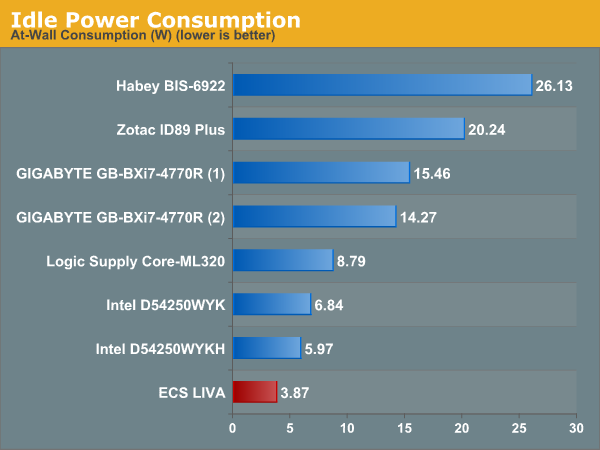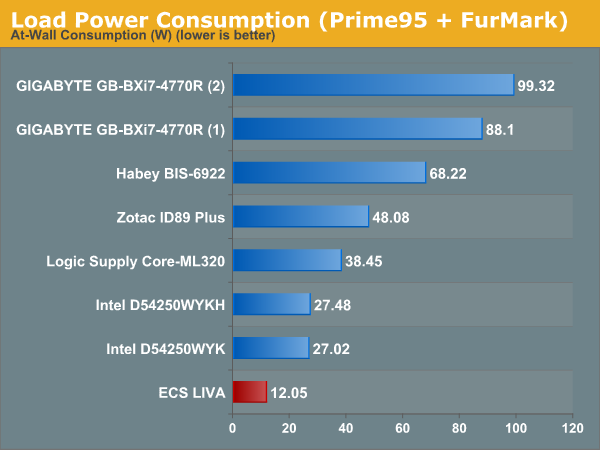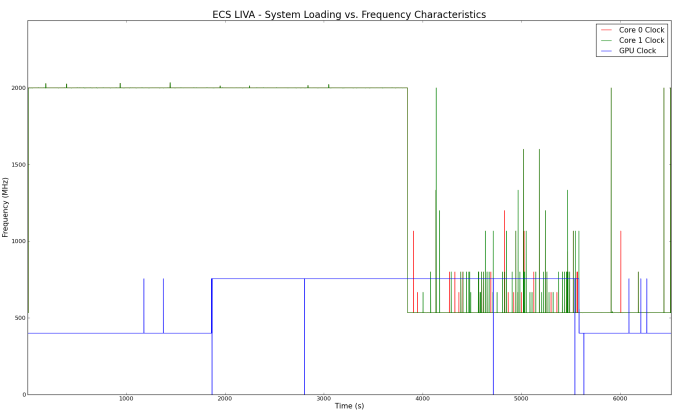ECS LIVA Review: The Nettop Rises Again
by Ganesh T S on July 18, 2014 9:15 AM ESTPower Consumption and Thermal Performance
The power consumption at the wall was measured with the display being driven through the HDMI port. In the graphs below, we compare the idle and load power of the ECS LIVA with other low power PCs evaluated before. For load power consumption, we ran Furmark 1.12.0 and Prime95 v27.9 together.


In order to evaluate thermal performance, we first ran our test for load power consumption and made sure that the unit wasn't getting throttled. In order to determine the efficiency of the cooling system, we first loaded up the CPU alone using just Prime 95 for around 30 minutes. This was followed by addition of the GPU load (FurMark) for another 30 minutes, and then removal of the CPU load for 10 minutes. The system was then left idle. The various frequencies and temperatures during this loading process are recorded in the graphs below.
The above graphs show that ECS has designed a 25% overclock into the Celeron N2806, operating it at 2.00 GHz throughout our CPU loading test (with and without the GPU loading). The GPU is also able to sustain the maximum dynamic frequency of 750 MHz+ without thermal issues. At idle, the cores drop down close to 500 MHz and the GPU drops down to around 350 MHz. On the temperature side, we see the temperature stabilizing at slightly less than 100 C. With a junction temperature of 105 C, I believe consumers don't need to worry about thermal throttling at usual room temperatures (~78 F was the ambient when we tested) irrespective of the load on the unit.












55 Comments
View All Comments
rheinlds - Friday, July 18, 2014 - link
It would be good on ECS's part to integrate a Bay Trail-M part with Quick Sync enabled in the LIVA kits. 32 GB of eMMC turns out to be very less after installing a couple of Windows updates. 64 GB should be the minimum, particularly since flash storage needs plenty of free capacity in order to maintain performance.In the Section above "...32 GB of eMMC turns out to be very less after installing a couple of Windows Updates..." Something seems to be missing from this sentence.
ddriver - Friday, July 18, 2014 - link
And 4 gigs of ram. With the price of ram being so low, it should be considered a crime to cripple x86 machines by installing only 2 gigs of ram.phoenix_rizzen - Friday, July 18, 2014 - link
It depends what you want to use them for.As an HTPC, more than 2 GB of RAM is really a waste, as you'll never use even that much (unless something goes horribly wrong with the running apps).
I have 3 homebuilt HTPCs at home (Athlon-XP w/1.5 GB of RAM running Windows XP; Athlon II X3 w/4 GB of RAM running Windows 7; Core2Duo w/2 GB of RAM running Windows 7) all running Google Chrome for Netflix and Plex Web. None of them even come close to using all the RAM.
Sure, if you're going to be doing a bunch of other tasks, then having more than 2 GB would be necessary. But as a pure HTPC, it's not required.
leexgx - Saturday, July 19, 2014 - link
2GB should be enough for windows 8 but could eat quite easily windows alone uses 1GB at least (i do not bother with any thing less then 4GB (even if the system is 32bit 3.25-3.5GB is usable as i seen some systems sitting at 2GB of ram and up to 3GB just checking for updates if office is installed)and 32GB for windows 8 is pushing it as well
johnny_boy - Sunday, July 20, 2014 - link
Depends, of course, on use case. I have an undervolted A10-5800K in my HTPC which I also use for gaming and dedicate 1gb ram for iGPU use. I also prefer to leave all the apps I use open so I don't haveto keep resstarting them. That doesn't leave much ram left, and I am running a relatively lean linux distro.DanNeely - Friday, July 18, 2014 - link
The bigger problem is just that eMMC is slow. I've got a last generation atom tablet/laptop hybrid with eMMC flash. It's tolerably fast 98% of the time, the other 2% something is thrashing the IO system and the flash is showing 100% load in task manager and ~4MB/sec throughput.kyuu - Friday, July 18, 2014 - link
Is your eMMC filled up? Just like with SSDs, you really have to keep a certain amount of it free in order to prevent speed degredation. In eMMC's case, the consequences will be more severe since it isn't nearly as fast as a proper SSD to begin with.Nowadays, eMMC is really pretty decently fast. Beats the hell out of an HDD. The main issue is that companies continue to insist on including so little of it, despite it being cheap as dirt.
jospoortvliet - Sunday, July 20, 2014 - link
As a media center pc, you would be an idiot to want to incur the performance and especially maintenance overhead of Windows... Download an xbmc Linux and be done. Memory and disk pace won't be an issue and an end user won't see any difference - yet no costs and no work keeping Windows safe and running. Right tool for the right job, people...djfourmoney - Wednesday, July 23, 2014 - link
XBMC -Tuner support is very limited to networked tuners and cable cards. I have DirecTV, none of the capture devices available work with Linux, especially in HD.
XBMC also has constant problems with the YouTube add-on. It's hardly updated and with Google often changing something in the code with YouTube, things like log-in gets botched up in XBMC. Last time I logged out believing it was another issue but the truth was a connection issue, U-Verse had gone down.
But I tried to log back in and I have yet to do the .py correction to allow log-in again. This would never be an issue with Smart TV's or Smart devices, they are updated and always work.
Windows has always been safe, don't visit silly sites and don't open email you don't know, pretty simple, not that you would be opening email on your HTPC????
I have a Llano based HTPC (upgraded from Athlon XP, Black Edition OC). Was able to remove the HD4670 (put in my mom's machine), cut down power usages quite a bit, Sliverlight Full Screen isn't an issue, maybe 20% CPU usage. Otherwise it's nearly idle on anything else. No driver issues which seems to always impact the performance of AMD hardware on Linux.
Finally there hasn't been a DVR program more solid or more reliable than Windows Media Center. The cost of adding it to Windows 8 is negligible and I also have 1GB dedicated to the GPU side of the APU, runs GRID and GRID 2 without issue, everything turned up (GPU slightly OC), but I play games on my PS3 not the PC but for some emulation.
HUBEMX - Sunday, July 20, 2014 - link
Anandtech: You should try OPENELEC!